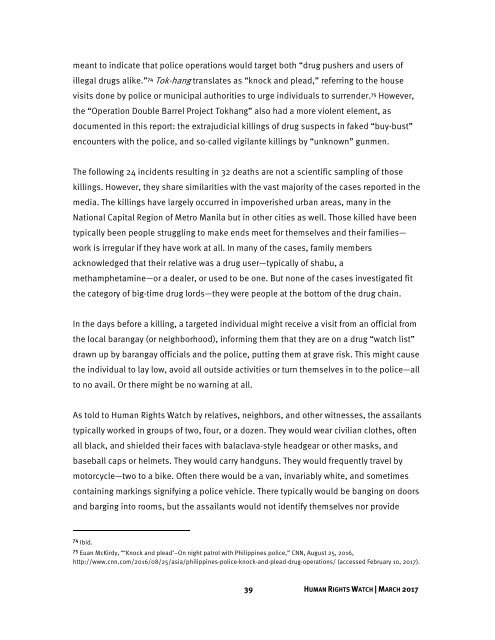“License to Kill”
nDPE309A46S
nDPE309A46S
You also want an ePaper? Increase the reach of your titles
YUMPU automatically turns print PDFs into web optimized ePapers that Google loves.
meant <strong>to</strong> indicate that police operations would target both “drug pushers and users of<br />
illegal drugs alike.” 74 Tok-hang translates as “knock and plead,” referring <strong>to</strong> the house<br />
visits done by police or municipal authorities <strong>to</strong> urge individuals <strong>to</strong> surrender. 75 However,<br />
the “Operation Double Barrel Project Tokhang” also had a more violent element, as<br />
documented in this report: the extrajudicial killings of drug suspects in faked “buy-bust”<br />
encounters with the police, and so-called vigilante killings by “unknown” gunmen.<br />
The following 24 incidents resulting in 32 deaths are not a scientific sampling of those<br />
killings. However, they share similarities with the vast majority of the cases reported in the<br />
media. The killings have largely occurred in impoverished urban areas, many in the<br />
National Capital Region of Metro Manila but in other cities as well. Those killed have been<br />
typically been people struggling <strong>to</strong> make ends meet for themselves and their families—<br />
work is irregular if they have work at all. In many of the cases, family members<br />
acknowledged that their relative was a drug user—typically of shabu, a<br />
methamphetamine—or a dealer, or used <strong>to</strong> be one. But none of the cases investigated fit<br />
the category of big-time drug lords—they were people at the bot<strong>to</strong>m of the drug chain.<br />
In the days before a killing, a targeted individual might receive a visit from an official from<br />
the local barangay (or neighborhood), informing them that they are on a drug “watch list”<br />
drawn up by barangay officials and the police, putting them at grave risk. This might cause<br />
the individual <strong>to</strong> lay low, avoid all outside activities or turn themselves in <strong>to</strong> the police—all<br />
<strong>to</strong> no avail. Or there might be no warning at all.<br />
As <strong>to</strong>ld <strong>to</strong> Human Rights Watch by relatives, neighbors, and other witnesses, the assailants<br />
typically worked in groups of two, four, or a dozen. They would wear civilian clothes, often<br />
all black, and shielded their faces with balaclava-style headgear or other masks, and<br />
baseball caps or helmets. They would carry handguns. They would frequently travel by<br />
mo<strong>to</strong>rcycle—two <strong>to</strong> a bike. Often there would be a van, invariably white, and sometimes<br />
containing markings signifying a police vehicle. There typically would be banging on doors<br />
and barging in<strong>to</strong> rooms, but the assailants would not identify themselves nor provide<br />
74 Ibid.<br />
75 Euan McKirdy, “‘Knock and plead’–On night patrol with Philippines police,” CNN, August 25, 2016,<br />
http://www.cnn.com/2016/08/25/asia/philippines-police-knock-and-plead-drug-operations/ (accessed February 10, 2017).<br />
39 HUMAN RIGHTS WATCH | MARCH 2017


